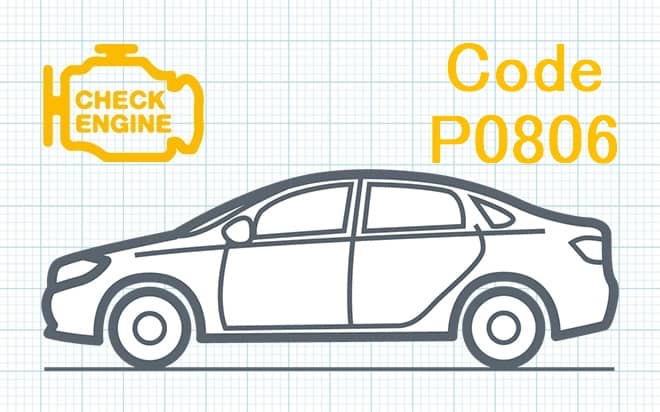
P0806 Clutch Position Sensor Circuit Range/Performance
Content
P0806 – OBD-II Trouble Code Technical Description
Trouble code P0806 indicates a clutch position sensor circuit performance range discrepancy.
What does the fault code mean P0806?
Trouble code P0806 indicates that the clutch position sensor circuit's operating range is not within specifications. This means that the engine control module (PCM) or transmission control module (TCM) detects a voltage or resistance discrepancy in the clutch position sensor circuit.

Possible reasons
Some of the possible causes of the P0805 trouble code are:
- Faulty clutch position sensor: The clutch position sensor itself may be damaged or faulty, resulting in an incorrect or no signal.
- Electrical problems: An open, short or open in the electrical circuit connecting the clutch position sensor to the transmission control module (TCM) or engine control module (PCM) can cause code P0805.
- Incorrect sensor installation or calibration: If the clutch position sensor is not installed or adjusted correctly, it may cause improper operation and trigger a DTC.
- Transmission control module (TCM) or engine control module (PCM) problems: Defects or malfunctions in the TCM or PCM responsible for processing signals from the clutch position sensor can also cause the P0805 code to occur.
- Clutch problems: Incorrect operation or malfunctions in the clutch, such as worn clutch plates or problems with the hydraulic system, can also cause the P0805 code.
- Problems with the car's electrical system: Certain problems with the vehicle's electrical system, such as insufficient power or electrical noise, can also cause P0805.
To accurately identify the cause of the malfunction, it is recommended to carry out diagnostics using specialized equipment or contact a qualified auto mechanic.
What are the symptoms of a fault code? P0806?
Symptoms for DTC P0806 may include the following:
- Gear shifting problems: Shifting gears may become difficult or impossible due to improper operation of the clutch or transmission system.
- Inactive starter: If your vehicle has a manual transmission, the clutch position sensor may be connected to the engine starting system. Problems with this sensor may make it impossible to start the engine.
- Changes in clutch behavior: Improper operation of the clutch position sensor may result in changes in clutch performance. This may manifest itself as a change in the clutch actuation point or in its characteristics.
- Reduced performance and fuel efficiency: Improper clutch or transmission operation can result in poor vehicle performance and increased fuel consumption due to improper gear shifting and power transfer to the wheels.
- Malfunction indicator indicator (MIL): When DTC P0806 is activated, the engine control module (PCM) or transmission control module (TCM) may turn on the malfunction indicator on the instrument panel.
- Deterioration in vehicle handling: Problems with the clutch system can cause changes in the vehicle's handling, especially when attempting to change gears.
If you experience any of these symptoms, it is recommended that you contact a qualified auto mechanic for diagnosis and repair.
How to diagnose a fault code P0806?
The following steps are recommended to diagnose DTC P0806:
- Connecting a diagnostic scanner: Use a diagnostic scan tool to read the P0806 error code and any other additional error codes that may be stored in the system.
- Symptom test: Inspect the vehicle and note any symptoms such as shifting problems, an inactive starter, or changes in clutch performance.
- Checking the Clutch Position Sensor: Test the clutch position sensor using a multimeter or other specialized tools to determine its functionality. Make sure it sends the correct signals when you press and release the clutch pedal.
- Checking electrical circuits: Inspect the electrical connections and connectors associated with the clutch position sensor and test the electrical circuits to ensure they are secure and not open or shorted.
- Transmission Control Module (TCM) or Engine Control Module (PCM) Diagnosis: If all of the above checks do not reveal the problem, diagnostics may be required and the transmission or engine control module may need to be replaced or reprogrammed.
- Checking Other Related Components: Sometimes problems can be related to other components of the transmission or engine control system, such as valves, solenoids, or wiring. Check these components for faults.
- Clutch check: Perform additional diagnostics on the clutch to rule out malfunctions that could affect the operation of the clutch position sensor.
These steps represent a general approach to diagnosis, and you may need to consult a qualified auto mechanic or use specialized equipment for more accurate diagnosis and repair.
Diagnostic errors
When diagnosing DTC P0806, the following errors may occur:
- Incomplete Clutch Position Sensor Testing: Incorrect or incomplete testing of the clutch position sensor may result in failure to be detected or incorrect interpretation of test results.
- Insufficient testing of electrical circuits: The electrical connections and circuits associated with the clutch position sensor must be thoroughly inspected and tested to ensure they are secure and operating properly.
- Incorrect interpretation of diagnostic results: Errors may occur due to misinterpretation of diagnostic results or use of incorrect testing methods. For example, incorrectly calibrating a multimeter or using diagnostic tools incorrectly can lead to incorrect conclusions.
- Problems with the transmission control module (TCM) or engine control module (PCM): Problems with the TCM or PCM may result in misinterpretation of signals from the clutch position sensor or misdiagnosis.
- Problems with other components: Sometimes problems can be related to other components of the transmission or engine control system, such as valves, solenoids, or wiring. Failure to check these components or exclude them from the diagnosis may result in an incorrect diagnosis.
- Use of incorrect spare parts: Replacing components without proper diagnosis or using low-quality or unsuitable spare parts may not solve the problem and may create additional difficulties.
To avoid these errors, it is recommended that you perform the diagnosis with a thorough understanding of the transmission and clutch control system, and use the correct methods and tools to identify and correct the problem.
How serious is the fault code? P0806?
Trouble code P0806 is a serious problem, especially because it indicates a problem with the vehicle's clutch or transmission system. There are several reasons why this code can be serious:
- Gear shifting problems: Incorrect operation of the clutch position sensor may result in difficulty or inability to shift gears, which may render the vehicle inoperable.
- Security: Incorrect operation of the clutch or transmission can significantly reduce vehicle controllability and increase the risk of an accident, especially when driving at high speeds.
- Risk of damage to other components: Continued use of a vehicle with a faulty clutch or transmission can damage other vehicle components such as the transmission, clutch, and even the engine.
- Fuel consumption and performance: Improper clutch or transmission operation can result in increased fuel consumption and decreased vehicle performance due to improper gear shifting and power transfer to the wheels.
- Increased repair costs: Ignoring the problem or delaying repairs can lead to more serious damage and, as a result, higher repair costs.
So, trouble code P0806 should be considered a serious problem that requires prompt attention and repair to prevent more serious consequences.
What repair will help eliminate the code? P0806?
Resolving trouble code P0806 depends on the specific cause of its occurrence, several possible repair actions:
- Replacing or adjusting the clutch position sensor: If the clutch position sensor is faulty or its readings are incorrect, replacing or adjusting it may help solve the problem.
- Checking and repairing electrical circuits: Diagnose and troubleshoot problems with electrical circuits, connections and connectors associated with the clutch position sensor.
- Transmission Control Module (TCM) or Engine Control Module (PCM) Diagnosis and Repair: If the problem is due to a faulty control module, it may need to be repaired, reprogrammed, or replaced.
- Clutch check and repair: If the problem is related to the malfunction of the clutch itself, then it is necessary to diagnose it and carry out the appropriate repairs or replacement of parts.
- Updating the software: In some cases, the problem may be resolved by updating the software in the transmission or engine control module.
- Checking Other Related Components: Perform additional diagnostics on other components such as valves, solenoids, wiring, etc. that may affect clutch or transmission performance.
It is important to carry out diagnostics using specialized equipment and contact a qualified auto mechanic to perform repairs. Only an experienced specialist will be able to accurately determine the cause of the problem and perform repairs correctly.
P0806 – Brand-specific information
Trouble code P0806 may have different meanings depending on the vehicle manufacturer, some of the meanings for popular brands are:
- Ford, Lincoln, Mercury: Code P0806 can mean “Clutch Position Sensor Circuit Range/Performance” or “Clutch Position Sensor Circuit Range/Performance”.
- Chevrolet, GMC, Cadillac, Buick: For these brands, P0806 may be related to “Clutch Position Sensor Circuit Range/Performance” or “Clutch Position Sensor Circuit Range/Performance”.
- Toyota, Lexus, Scion: For these brands, the P0806 code may mean “Clutch Position Sensor Circuit Range/Performance.”
- Honda Acura: For Honda and Acura, P0806 may indicate “Clutch Position Sensor Circuit Range/Performance.”
- Volkswagen, Audi, Skoda, Seat: For these brands, P0806 may be related to “Clutch Position Sensor Circuit Range/Performance” or “Clutch Position Sensor Circuit Range/Performance”.
These are general definitions, and the specific meaning of the P0806 code may vary depending on the model and year of the vehicle. It is recommended that you consult the repair and service manual for your specific make and model of vehicle for accurate information.

